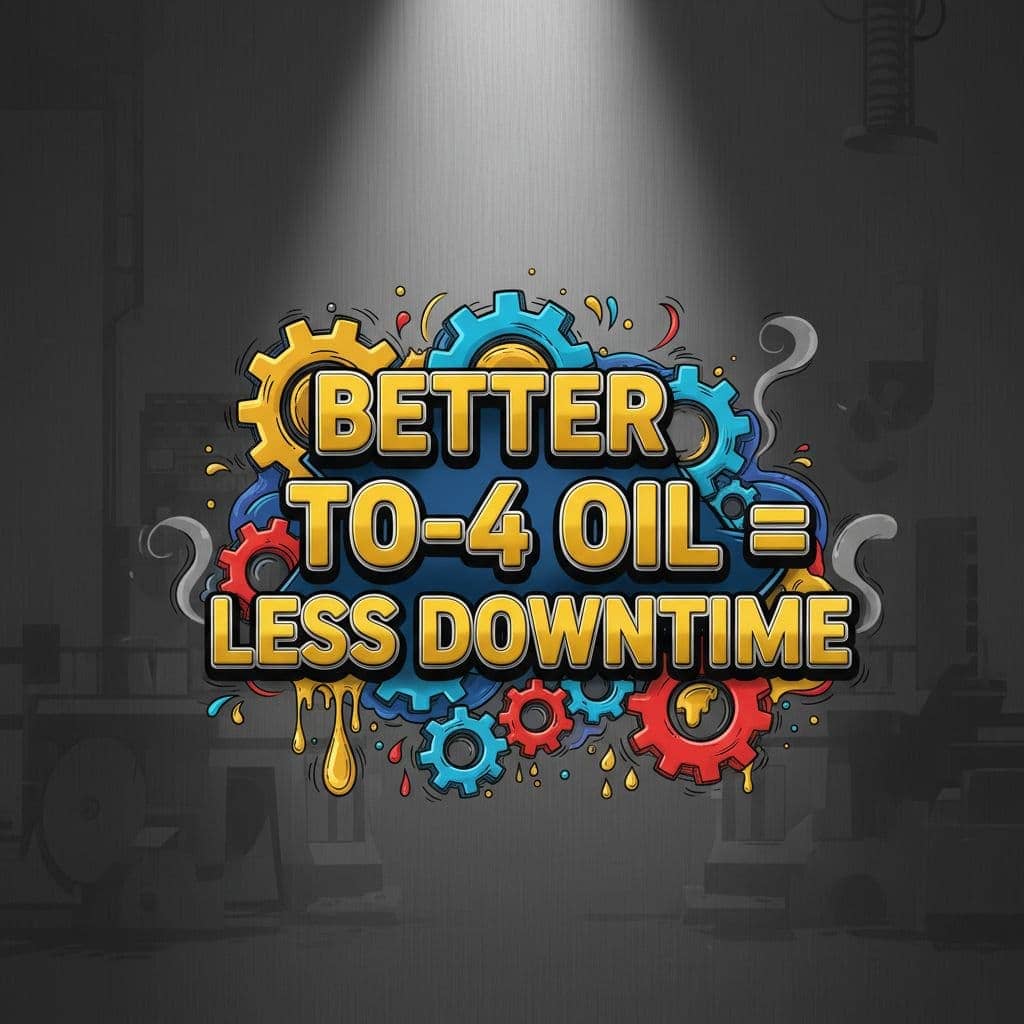Caterpillar’s TDTO TO-4 specification defines the exact lubrication behavior required to keep heavy-duty transmissions, final drives, and hydraulic systems operating within design tolerances. Selecting a proper TO-4 equivalent is a technical decision rooted in friction balance, film strength, and thermal stability—three variables that decide whether a machine shifts smoothly or grinds itself toward failure.
Seal and elastomer integrity complete the picture. The additive balance must protect nitrile, Viton, and polyurethane seals from shrinkage or embrittlement, keeping housings tight and preventing fluid loss under high thermal stress. A TO-4 oil that fails this test might protect gears yet destroy its own containment system.
Some formulations go beyond the minimum TO-4 requirements, using higher-purity synthetic base oils and more thermally stable additive systems to maintain performance where conventional fluids begin to fail. A fully synthetic design, such as those developed for advanced power-shift transmissions, illustrates how exceeding TO-4 friction and oxidation parameters can extend component life and reliability under continuous heavy load.
Within that performance spectrum, AMSOIL’s synthetic Powershift formulation exemplifies how a TO-4 fluid can translate those laboratory metrics into measurable field durability. Viewed objectively, the AMSOIL formulation functions as a case study in how modern synthetic design converts laboratory precision into field reliability. It serves as a reference point for how custom-engineered lubricant chemistry defines the upper performance limit of TO-4-grade transmission oils.

Operating environment remains the primary variable. Equipment exposed to sustained torque loading or elevated sump temperatures benefits from a fully synthetic TO-4 formulation engineered for oxidative stability and consistent viscosity under stress. Its controlled molecular structure maintains clutch modulation and hydraulic response even when operating conditions push beyond the range tolerated by mineral oils.
Compatibility must still govern the final decision. The chosen fluid has to conform to Caterpillar’s TO-4 requirements for friction behavior, seal integrity, and hydraulic efficiency regardless of base-oil type.
For more details on advanced synthetic transmission fluids engineered for heavy-duty power-shift systems, explore this technical overview Here.
In effect, TO-4 oil is both coolant and structural element—carrying away heat while transmitting hydraulic force. The reliability of any CAT powertrain depends on maintaining this balance; neglecting it shortens component life, reduces efficiency, and eventually compromises the transmission’s ability to perform as designed.
Power-shift transmissions form the mechanical core of many Caterpillar machines, including dozers, loaders, and haul trucks. These systems are designed to transfer torque smoothly through hydraulic control rather than manual gear engagement, allowing the operator to shift under load without interrupting power delivery. Their performance depends entirely on maintaining correct hydraulic pressure and fluid integrity within the transmission circuit.
The operating principle centers on a combination of planetary gear sets, torque converters, and multiple clutch packs. The transmission fluid serves as both hydraulic medium and lubricant, activating the clutch assemblies while protecting the moving parts from wear. During gear engagement, the oil must sustain precise pressure to fill clutch pistons instantly, engage the torque converter, and maintain uniform torque transfer across the gear train.
Planetary gear assemblies require continuous lubrication to minimize friction between meshing teeth and distribute load evenly. A stable oil film prevents scoring and pitting under the high contact stress typical of heavy machinery.
The torque converter depends on the fluid’s viscosity and thermal stability to translate engine output into rotational force for the transmission input shaft. Any loss of viscosity weakens torque multiplication and raises heat generation, leading to efficiency loss.
Clutch packs demand the highest fluid precision of all. Their friction materials rely on the oil’s additive balance to grip and release smoothly; contamination or oxidation alters this behavior immediately. A true TO-4 formulation maintains the friction coefficient within narrow tolerances, ensuring predictable engagement and extending clutch life under repeated high-load cycles.
Hydrostatic transmissions are widely used in compact track loaders, skid steers, and many excavators where precise speed control and smooth directional changes are essential. Unlike power-shift systems that rely on gears and clutch packs, hydrostatic drives operate entirely on fluid power, converting hydraulic energy directly into mechanical motion.
The core mechanism consists of a variable-displacement pump connected to one or more hydraulic motors. The pump regulates oil flow and pressure to control both direction and torque output. The fluid itself becomes the medium of power transfer, carrying force through pressure rather than through physical contact between gears.
Oil viscosity is critical to this process. The fluid must be thin enough to flow rapidly through valves and control passages yet thick enough to maintain a continuous lubricating film within the pump and motor assemblies. If viscosity drops too low, internal leakage increases and efficiency falls; if it rises too high, response slows and heat builds in the circuit.
Cleanliness is equally vital. Even microscopic contamination can erode valve surfaces or score pump pistons, gradually reducing system precision. A properly maintained TO-4 or equivalent hydraulic oil keeps these systems balanced—preserving viscosity, minimizing friction, and ensuring that every pressure change translates into controlled, efficient movement.
Poor lubrication or low-quality oil introduces a series of mechanical and chemical failures within CAT transmission systems. These failures often appear gradually but compound quickly, reducing both performance and service life. Each symptom traces back to a breakdown in the oil’s ability to maintain film strength, control temperature, and protect against contamination.
Friction and slippage occur when degraded oil loses its frictional balance, allowing clutch plates to slide instead of engage cleanly. Power transfer becomes inconsistent, generating heat and accelerating wear across clutch packs. What begins as minor hesitation can escalate into torque loss and mechanical scoring within a single operating cycle.
Wear and surface fatigue follow when lubrication fails to separate moving parts adequately. Gear teeth, bearings, and hydraulic pistons are then exposed to direct contact under high pressure, producing abrasive wear, pitting, and micro-welding. Once wear debris circulates, it accelerates internal erosion throughout the system.
Contamination risk rises as moisture, dirt, and oxidized residues enter the fluid. These particles form varnish and sludge that restrict valve movement and reduce hydraulic efficiency. The resulting stick-slip behavior in control circuits often leads to erratic shifting and delayed clutch response.
Overheating develops when poor-quality oil cannot dissipate frictional heat or resist thermal breakdown. Elevated sump temperatures thin the fluid and trigger oxidation, which in turn darkens the oil and increases its acidity. The cycle of heat and degradation quickly leads to premature transmission failure.
Seal and O-ring deterioration completes the chain of damage. Oils formulated without proper elastomer compatibility cause swelling, hardening, or cracking in rubber components. Once seals fail, leaks introduce air and contamination, compounding the mechanical stress already present in the transmission.
In every case, substandard lubrication converts a precisely balanced hydraulic system into a high-friction, heat-generating environment. Maintaining TO-4-grade oil integrity is therefore not a procedural detail—it is the primary safeguard against cumulative failure.
High-quality TO-4 oil plays a defining role in the performance and longevity of Caterpillar transmission systems. The choice between conventional and synthetic formulations directly affects how efficiently a machine manages heat, friction, and long-term wear. Synthetic TO-4 lubricants, engineered with precise molecular control, deliver measurable advantages in thermal stability, viscosity retention, and film strength under severe operating conditions.
Superior thermal stability is one of the most significant gains. Synthetic base oils resist oxidation and breakdown at elevated temperatures, maintaining viscosity and preventing the sludge formation that typically shortens oil life in conventional fluids. This property becomes critical in equipment operating under sustained high-load or high-temperature cycles.
Cold-weather performance also improves markedly. Synthetic fluids maintain their flow characteristics at lower ambient temperatures, ensuring rapid lubrication of moving parts during start-up. Faster oil circulation minimizes dry friction and surface wear in bearings, clutches, and gear assemblies.
Enhanced wear protection results from advanced additive chemistry combined with uniform molecular structure. The oil forms a resilient boundary film that prevents metal-to-metal contact even when torque spikes or hydraulic pressures peak. This controlled friction behavior directly extends the lifespan of heavily loaded transmission components.
Stronger film strength further differentiates synthetic formulations. Their consistent molecular arrangement maintains a uniform lubricating layer, resisting shear and collapse under high contact stress. This stability reduces scuffing and scoring in power-shift systems subjected to constant load reversals.
Extended drain intervals become practical due to improved oxidation resistance and contaminant control. The fluid maintains protective properties for longer operating hours, reducing downtime and overall maintenance cost without sacrificing reliability.
Reduced varnish and deposit formation ensures that valves, pumps, and clutch assemblies continue to operate freely. Clean internal surfaces preserve hydraulic precision and prevent the sluggish response common in systems contaminated by oxidized residue.
For operators working under demanding conditions, whether continuous high heat, extreme load cycles, or wide temperature swings, a premium synthetic TO-4 lubricant offers measurable gains in durability, efficiency, and service life. Its chemistry provides not only protection but also consistency—keeping the transmission stable, predictable, and responsive across every operating condition.
Maintenance discipline determines how long a Caterpillar transmission performs to its design limits. Even the best-formulated TO-4 oil cannot compensate for neglected service practices. Effective maintenance programs rely on consistent monitoring, timely oil replacement, and proper handling procedures to preserve both fluid integrity and mechanical precision.
Routine oil analysis remains the foundation of preventive care. Regular sampling identifies wear metals, contamination, and viscosity changes before they escalate into component failure. Trends in iron, copper, or silicon levels provide early indicators of gear wear, bearing distress, or external dirt ingress, allowing corrective action before downtime occurs.
Oil change intervals should reflect real operating conditions rather than fixed hour counts. High-load, high-heat environments accelerate oxidation and additive depletion, demanding shorter cycles, while light-duty or intermittent operation may allow extended intervals. Matching service schedules to actual usage keeps lubrication within its effective range.
Proper storage and handling are equally important. TO-4 fluids must be kept sealed, dry, and out of direct sunlight to prevent moisture absorption and oxidation before use. Contaminated storage drums or transfer equipment can undermine lubricant performance long before it reaches the transmission.
Selecting the correct viscosity grade—typically SAE 10W, 30, or 50—ensures that the fluid maintains proper film thickness across expected temperature ranges. Too light a grade can reduce protection under heavy load, while too heavy a grade increases drag and impairs cold-start response.
Monitoring transmission performance provides real-time confirmation of lubricant health. Hard shifting, delayed engagement, rising operating temperatures, or unusual mechanical noise often signal degraded oil or early mechanical wear. Prompt inspection and fluid testing at the first sign of these symptoms prevent minor lubrication problems from becoming major mechanical failures.
In practice, maintenance best practices extend beyond scheduled servicing; they represent a continuous feedback loop of testing, observation, and adjustment. When combined with a stable, properly specified TO-4 lubricant, these habits form the core of long-term drivetrain reliability.
For detailed specifications and further insights into CAT transmission maintenance, you can refer to the comprehensive guide provided by Caterpillar Here.
High-quality synthetic TO-4 fluids extend operating life not because of marketing claims, but because they hold viscosity, resist acid formation, and reduce boundary wear when the system runs at full thermal load. When those fundamentals are controlled, downtime drops, rebuild intervals stretch, and the transmission performs as designed—no more, no less.
